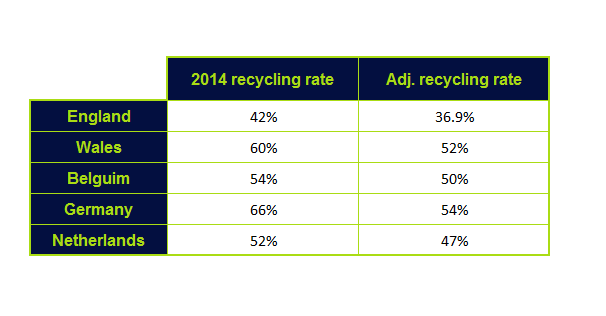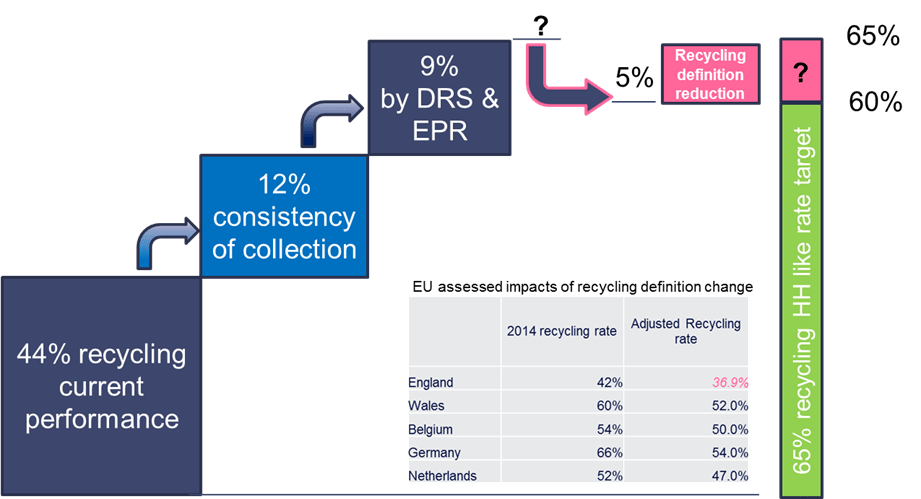The waste and resources strategy: understanding the goals

It’s great to see that in the various consultations under the waste and resources strategy we are being asked to achieve more success in prevention, minimisation and recycling, as well as ensure that we complete the move away from landfill. It’s even better that we are being asked to consider achieving stretch targets in recycling, moving from a national average just above 44% to 65% or more in 2035.
The four consultations on the consistency of collection of materials from households and business, on the revision of the extended producer responsibility scheme for packaging, the proposals to introduce a deposit return scheme for beverage containers and that on tax to promote recycled content in plastic packaging will all help change the system and support not only an increase in recycling but also design changes in products and hopefully the removal of unnecessary packaging. In fact the consultations themselves appear to bank a 4% uplift in recycling rates for plastic packaging against format and design changes.
Also included in those proposals are series of measures around performance, benchmarks, efficiency and payments that also link back to the recycling targets. So, although we should welcome the ambition, we need to make sure that the targets can be achieved given the variety of measures being introduced.
One consideration for the overall recycling rates and the packaging recycling rates is the new definition of recycling coming from the EU Circular Economy Package, which introduces a new baseline of measurement. It is calculated as the input into the reprocessing plant minus the process losses in the reprocessing. When the EU modelled this originally, their figures suggested that most countries would see a drop in their declared recycling rates and the UK was no exception.
In the UK, our national recycling rates have traditionally been declared at the ‘collected for recycling’ stage, i.e. the weight of materials collected for recycling and delivered to the sorting plant or reprocessing plant. For the packaging targets the measurement point is different and has been set at the entry to the reprocessing plant or point of export (for the Packaging Waste Recovery Notes (PRNs) and Packaging Waste Export Recovery Notes (PERNs) respectively.
When the work was originally done, it was based on 2014 figures, but you can see from the figures in the table below, that the impacts of this definition change were potentially significant.
The figure for England is a SUEZ calculation, as we were unable to find a specific figure from the EU work. At a recent conference a representative of the German market suggested that the German recycling rate might drop below 50% when the new recycling rate is declared under this new definition.
Talking in the industry it’s not uncommon to hear discussion of process losses (through contamination or the actual process of sorting the materials) in sorting plants to vary between 10% and 20% and for reprocessing losses (those incurred after the PRN/PERN point of evidence and due to contamination or the process itself) to vary from 5% to in excess of 30% depending on the stream.
So if we follow the new definition and it’s applied in the way we think, then our recycling rates would need to be corrected to match the new definition. For packaging this will reduce the effective recycling rate by a few percent, but for general recycling rate this might be more significant.
For packaging we note that the EU Member States have approved the calculation methods for the recycling targets for packaging. These new documents are quite complex and their implementation will take some fettling in each member state but, from our first look, we think there are some common strands, namely:
- The ‘calculation and measurement points’ is the point where the packaging materials are measured and enter the recycling operation whereby waste is reprocessed into products, materials or substances that are not waste and is common to where our point of evidence is currently measured.
- Non-target materials (i.e. contamination or packaging that could be recycled, but is delivered to a plant that is not designed for it and cannot therefore achieve ‘end of waste’ (EoW) or product status for it) need to be deducted from the total materials delivered.
- Residues of products left in the packaging need to be excluded from the materials declared as recycled, so some measure of this needs to be undertaken at the receiving plant. (Leftover shampoo in a shampoo bottle for instance).
- For biological packaging (compostable or digestible), front-end testing will need to be undertaken to determine which incoming materials are compatible with the process and their volume. The declared recycling rate would then be this weight of target material minus the target packaging that is removed ‘before, during or after’ the recycling operation and the deduction of any moisture content (humidity) in excess of that present in the packaging when originally placed on market.
Therefore, if my reading and logic are correct, the reported volumes would be input to the recycling plant that takes that product to EoW status minus practicably calculable losses due to non-target packaging (for the receiving plant), excess water, non packaging or residues and minus target input materials that (for some reason) don’t achieve EoW status in the plant to which the reporting applies.
For organics (food and green waste) the issues are slightly different. Why? You might ask. Well, for organic recycling we currently declare the materials delivered to the facility as being recycled, but if the principles of the new definition are applied to these processes the process losses (moisture loss and materials loss in the biological process) might need to be deducted from the tonnage of material delivered which would have the effect of reducing the overall recycling rate. The measure might be on the weight of compost or digestate meeting a quality standard and end of waste and placed back to land.
So, although I welcome the change to the definition as it forces a focus on quality of product and that should renew the focus on avoidable contamination and efficient processing, I worry that the current consultation documents seem to be more based on the old definition and not the new one. To illustrate my point, I have simply taken the figures for recycling performance from the consultation documents and placed them into a graph and then shown the potential impact of the definition change.
It’s possible therefore that all the payments and benchmarking for improvement and efficient extraction of materials may not be based on the completely correct metric and might lead to incorrect and unfair application.
We have covered off the quantum of change in the recycling targets, but what about timing? Given that the policy changes won’t come into effect until around 2023, I expected that England will not meet its 2020 recycling targets of 50%, and given we only have two years from new policy to the 2025 target of 55% its likely we will fail to achieve that milestone as well. So our first target that could be achieved is the 60% recycling target in 2030 (70% by 2030 for packaging) but to do this we must meet all the legislative timelines and be prepared, across the industry to quickly invest in the systems of harvesting products from households and businesses and sorting, refining and reprocessing that will be necessary to achieve these goals. This will not be easy and there should be a focus of responses to the applicable questions in the various consultations, especially from businesses who are targeted to deliver much of the UK recycling uplift.
Finally, we must work on all the recyclable streams and as such I think all forms of packaging should be included in the consistency of collection and EPR process and flexible packaging and compostable packaging needs to be a target for recycling and be used to support the recycling target delivery.

